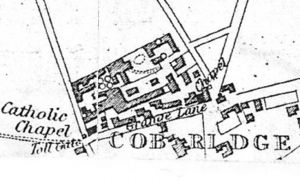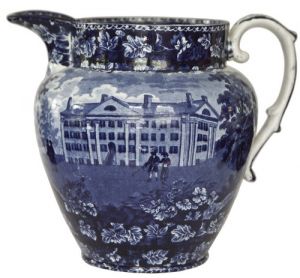Ralph Stevenson (& Son)
|
In December of 1800 John and William Dale, and George and Samuel Poulson of Cobridge, Staffordshire earthenware manufacturers, decided to go their separate ways, the business was to be continued by a new partnership between John Dale and Ralph Stevenson trading as Stevenson & Dale.[3] In 1802 Benjamin Godwin joined the partnership and when John Dale died in April of 1803 the firm continues as Stevenson & Godwin[4]. In 1807 Ralph married Mary Mayer, daughter of the potter John Mayer, and shortly after he purchased land and premises in Cobridge including an earthenware manufactory and a color-works specializing in the processing of cobalt[5]. It may have been that Ralph purchased part of the Stevenson-Godwin business because by November of 1810 the partnership with Benjamin Godwin was over, with an agreement that in future the Upper-Manufactory will be carried on by Benjamin Godwin and Sons-and the Lower one by Ralph Stevenson.[6] So from the end of 1810, Ralph Stevenson was in business by himself, perhaps for the first time. He continued to own a color works where he was in partnership with Thomas Maydew trading variously as Colour Manufacturers, blue colourists, and refiners of zaffre.[7] Not surprisingly Ralph Stevenson became a major manufacturer of blue-printed pottery. It was not an easy time to be in business, trade restriction imposed by France and England drew a response from America and by 1812 the climate was dire for all kinds of manufacturers. Ralph Stevenson was elected by his fellow Staffordshire potters to accompany Josiah Wedgwood II to give evidence to a House of Commons enquiry into the state of trade. Ralph had all the facts and figures at his fingertips, giving a thorough overview of the declining state of the pottery industry. In answer to questions, he reported that the vastly important American market had been closed to them since February 1811; that only two-thirds of the workers in the pottery industry were in employment; that 35 factories had stopped work and 15 or 16 had failed altogether. To further his own depressed business, he had shipped world-wide but that “at Buenos Ayres the market glutted … Trade to the West Indies declined, and … [he had] shipped to British America, but the speculation has not succeeded. Has shipped to Sicily and Malta, where the loss was 25 to 30 per cent” he concluded “An open trade to America would remove the distress of the Potters in Staffordshire.”[8] But it was to be a few years before open trade was resumed. Not only was Britain at war with France but in June 1812 America also declared war on Britain and peace was not restored until 1815. Almost immediately after the cessation of hostilities, ships left Liverpool for the ports on America’s eastern seaboard, carrying crates of Staffordshire pottery. No doubt, Ralph Stevenson’s pottery was soon taking its place in its most important market. Blue printed wares dominated his productions, but he also made stone-china and bone-china. Surprisingly Stevenson ended his partnership with Thomas Maydew in January of 1821, leaving the color-maker to work alone until 1824-25 when Stevenson reclaimed his color works and converted it into a china factory. [9] By 1824 Ralph Stevenson had taken Augustus Aldborogh Lloyd Williams into partnership trading as Stevenson & Williams and they were soon joined by Samuel Alcock. Change came by August 1826 when the partnership divided, with Stevenson and Lloyd Williams continuing as “Potters”, and Stevenson and Alcock continuing as “Samuel Alcock & Co.” to make “china”.[10] Between 1824 and 1827, Ralph Stevenson & Williams made a range of pottery products and incorporated the initials RSW into printed marks. A number of designs are known marked with blue-printed pattern names some with and some without the initials RSW, for example see Harvard College marks illustrated to the right. While it has been generally thought that this whole series of patterns was made during the Ralph Stevenson & Williams partnership, it is just as likely that patterns without the RSW initials were made before or after the short partnership period. Interestingly, in the middle of the Stevenson & Williams partnership a rare advertisement appeared the in the Aurora & Franklin Gazette of May 24, 1826 listing 167 crates and hogsheads of “earthenware from the manufactory of Ralph Stevenson” to be auctioned by Bowen & Richards, one of Philadelphia’s leading merchant houses. When his partnership with Williams was dissolved in 1827 and with Alcock expired in 1831, Ralph took his oldest son, John Adams Stevenson into business. Ralph Stevenson & Son was listed as both earthenware and china manufacturer[11]. In 1831 Ralph Stevenson’s daughter Mary married George Alexander Brown, late of Baltimore. He was the cousin of William Brown who founded the firm of Brown, Shipley & Co., of Liverpool. His continued presence in Liverpool suggests that George Alexander was working for, or with, his cousins in their merchant shipping establishment. No doubt his father-in-law Ralph Stevenson appreciated the inclusion of an American born merchant in his family circle. Just as it seemed the family was settled, the pottery was prospering, and trade was brisk, new challenges arose that ultimately led to the failure of the business. What began as a small series of industrial disputes in the Potteries town of Tunstall, escalated into a succession of strikes and violent protests spreading to Burslem in 1834-35 and on to the other Potteries towns by 1836. Many of the manufacturers were unable to continue business, and one of the casualties was Ralph Stevenson and Son. In 1835 the first notice of their bankruptcy appeared in the Staffordshire Advertiser, and in April of 1836 the Bankruptcy was official.[12] During his 30 or more years as a potter, Ralph Stevenson produced an amazing variety of earthenware, stoneware, and bone-china, but he is probably best remembered for the quantity and quality of his blue-printed pottery. For an abstract of Ralph Stevenson’s evidence to the House of Commons click here For more on the Ralph Stevenson’s partnership with Samuel Alcock and Lloyd Williams click here. [1]James christened 1774; Ralph christened; 1776, Mary christened 1777; Andrew christened 1780. Burslem Parish Registers [2] Jones's directory; or, useful pocket companion, for the year 1789 … containing an alphabetical list of the names and places of abode of the merchants, manufacturers, traders, and shopkeepers, in and about the city of Glasgow. Printed for the editor by John Mennons, in Glasgow. [3] Staffordshire Advertiser, January 24, 1801. quoted in Hampson, Rodney. 2000. Pottery References in the Staffordshire Advertiser 1795- 186. Kendal, Cumbria, Northern Ceramic Society. Dale also assumed a role in the Stevenson’s Glasgow retail business which was eventually acquired about 1816 by Ambrose son of John Dale [4] Holden’s Triennial Directory 1805 [5] . Thomas Maydew & Co. operated the “colour-works” and is listed in trade directories as a “blue colourist” and “refiner of zaffre” from 1805 to 1822. Stevenson was partner in the business until 1821, when Thomas Maydew continued alone for a year or so. [6] London Gazette November. 5, 1811 [7] Trade Directories 1809-1822 see bibliography [8] For an abstract of the evidence given by Josiah Wedgwood and Ralph Stevenson to the House of Commons committee, click here [9] Emery, N. “The Stevensons of Staffordshire”, The Magazine Antiques, June 1955, pp.494-5 [10] Staffordshire Advertiser August 19, 1824 notes a fire in the counting house of Stevenson & Williams see Hampson, Rodney. 2000. Pottery References in the Staffordshire Advertiser 1795- 186. Kendal, Cumbria, Northern Ceramic Society And London Gazette May1, 1827 records partnership changes dating from August 11, 1826. [11] White’s Directory 1834 [12] Staffordshire Advertiser, December 26, 1835., see Hampson, Rodney. 2000. Pottery References in the Staffordshire Advertiser 1795- 186. Kendal, Cumbria, Northern Ceramic Society. And London Gazette April 5, 1836. |
Notice in Glasgow Directory 1803  Mug, early 19th century form and design with impressed mark STEVENSON currently attributed to Ralph Stevenson Mug, early 19th century form and design with impressed mark STEVENSON currently attributed to Ralph Stevenson with printed mark of Ralph Stevenson & Williams partnership c.1824-27  Plan of Ralph Stevenson's Pottery, showing workshops and ovens, the later indicated by circles Plan of Ralph Stevenson's Pottery, showing workshops and ovens, the later indicated by circlesHargreaves map 1832  Stone china plate with printed mark of the Ralph Stevenson, Williams partnership c. 1824-27  Stone china plate with the mark of the Ralph Stevenson Williams partnership c.1824-27  Deaf and Dumb Asylum, Hartford Ct. |

 Born in 1776 in Burslem Staffordshire, Ralph Stevenson was
the second child of Ralph and Ann Stevenson.
His father, died in 1784 and when his mother married the potter Benjamin
Godwin in 1790, Ralph, his older brother James and his younger brother Andrew
Born in 1776 in Burslem Staffordshire, Ralph Stevenson was
the second child of Ralph and Ann Stevenson.
His father, died in 1784 and when his mother married the potter Benjamin
Godwin in 1790, Ralph, his older brother James and his younger brother Andrew